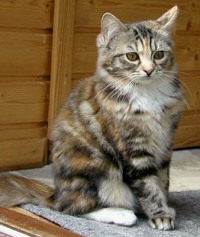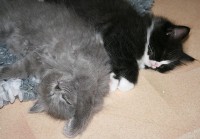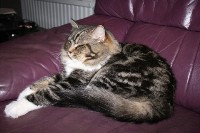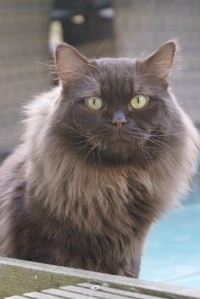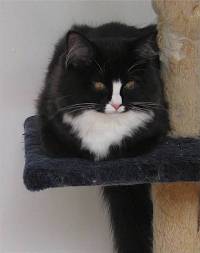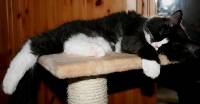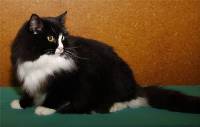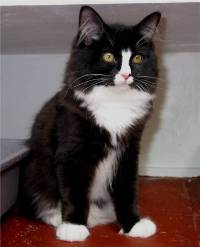History
On July 3rd, 1965 Ann Baker of Raggedy Ann cattery in California, USA. had a litter of four kittens
born to Buckwheat, a Black Self coloured female cat, carrying the sepia gene, and Daddy Warbucks,
a Seal Mitted male pointed cat. In this litter were two self coloured and two pointed kittens.
The self coloured kittens were named Gueber, a Black male and Mitts,
a Black Mitted male and the pointed kittens were named Tiki,
also known as Toni, a Chocolate Point female and Kyoto, a Seal Mitted male.
Raggedy Ann Tiki and Raggedy Ann Kyoto were registered as Ragdolls with NCFA by Ann Baker
and Gueber and Mitts were registered with the same body as experimental Persians.
When Gueber was mated with Raggedy Ann Toy Ling, the offspring of Tiki and Kyoto, the resulting kitten was Raggedy Ann Adam, born 11th June, 1967 and he was also registered with NCFA as an experimental Persian.
For some years the pointed Ragdolls were the favoured ones and the self coloureds were ignored.
Ann Baker did not bother with them either and gave them to a friend to care for but by the early 1970's,
when she had formed her own registry, IRCA, she decided to reintroduce the self coloureds, or solids,
because she then believed they were important to help maintain the size and eye colour of the pointed
Ragdolls and she called them Ragdolls Tu. Since IRCA was not a recognised body the pedigrees of many
cats, including self coloureds, registered with this registry were never recognised and tend to be
'controversial' even to this day. They are often seen listed on pedigrees from other registries as "Foundation".
Self Coloured Ragdolls, Solids, Selfs or Non-pointeds as we know them today, are now more widely
accepted and many breeders recognise their valuable genetic contribution to the breed.
A self coloured parent with a pointed parent will produce a mixed litter of pointed and self coloured
kittens because the self coloureds all carry the pointing gene, whereas two pointed parents
will only produce pointeds. A self coloured cat is never bred to another self coloured cat
because the pointing gene may then be lost from that gene pool.
In a self coloured Ragdoll the body and the points (nose and ears, legs and tail) are the same colour,
in contrast to pointed Ragdolls, which have points which are darker than the body colour.
Self coloured Ragdolls are available in all of the same colours and patterns as the pointed Ragdolls
except that black replaces seal.
The self coloured kittens, or solids, are born with full body colour
and blue eyes but their eye colour begins to change at around 7 weeks of age and continues
to develop to shades of green, blue-green, copper or gold as they mature.
Another genetic colour variation present in many Ragdolls throughout the World creates the
Sepias and Minks. This gene, originally from the Burmese breed, alters the basic colour of pointed Ragdolls.
In a Sepia the body colour is a slightly lighter colour than their points and in a Mink the body coat colour
has a lighter shade than their points but not as light as in a normal pointed cat of the same basic colour.
This gene affects all of the colours available in Ragdolls. Cats with two copies of the sepia gene
are sepia in colour whilst cats with a single copy of the sepia gene paired with a
single copy of the sepia pointing gene are Minks.
Self coloured Ragdolls may also carry a single copy of the sepia gene coupled with
the dominant gene for self colour. Thus they could produce self coloured and mink pointed
kittens when mated to a normal colour pointed Ragdoll.
We are captivated by the self coloureds, or solids, and we have been privilidged to be one
of the growing number of Ragdoll breeders throughout the World who do not want this line to be lost
but want to promote the Self coloured Ragdolls. We now have had many litters of self coloured Ragdolls.
For our self coloured kittens we have added "Tu" to their pedigree name.
We can trace our original self coloured stud's pedigree back to the first non-pointeds,
Raggedy Ann Adam and Raggedy Ann Tiki's sibling, Gueber.
|



